Aram Saroyan and the Art of the One-Word Poem

A really perfect poem has an infinitely small vocabulary.
—Jack Spicer, “Second letter to Federico García Lorca”
Writing in 1961, at the founding of the Oulipo (Ouvroir de littérature potentielle) movement, Raymond Queneau and François Le Lionnais, two of France’s most significant postwar literary experimentalists, wondered to one another “how few words can make a poem?”
According to Le Lionnais, this question would preoccupy the two until Queneau’s death 15 years later. Even in 1976, they doubted that a poem could be constructed from fewer than several words. Perhaps because their backgrounds were not primarily in experimental poetry or postwar art (Le Lionnais was a mathematician and Queneau primarily an editor and novelist), the two oddly overlooked concrete poetry, a form of visual poetry that uses the arrangement of words to convey meaning. The two also seemed unaware of the work of Aram Saroyan, whose mid-1960s poems explored and broke the limits proposed by Queneau and Le Lionnais.
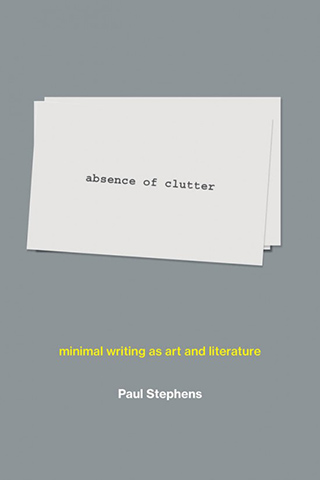
Though the Oulipo’s founders may have been underinformed about concrete poetry, their skepticism is telling: Setting aside concrete poetry in the 1950s, it was not until the 1960s with the contemporaneous emergence of pop art, minimalism, and conceptual art that a single word or letter could be recognized as a poem.
The one-word poem may in fact have rapidly reached the height of its popularity in late 1967 with the final issue of Ian Hamilton Finlay’s journal Poor. Old. Tired. Horse. In July of that year, Finlay wrote to Saroyan — then only 24, but a leading practitioner of the form — that he intended to put together an entire issue of P.O.T.H. devoted to one-word poems:
the idea being that the poem consists of one word and a title. These are to be thought of as 2 straight lines, which make a corner (the poems will have form); while the paradox of these corners is, that they are open in all directions. This is because we can’t have whole-world poems (we haven’t got one), but at the same time we should not despair of something with corners, such as making them, and opening them up.
As can immediately be discerned from Finlay’s letter, the rubric “one-word poem” is slightly misleading. All of the poems included in the issue featured a title, and most of the titles were longer than a single word. Following Finlay’s lead, I too consider as one-word poems not merely a single word in isolation on the page, but a single word repeated per poem or per page (or other unit of publication) that is repeated (in whole or in part) as a series. This expansive definition would include many notable concrete poems — for instance, Eugen Gomringer’s “silencio” or Finlay’s “ajar” or Mary Ellen Solt’s “Zinnia” — and my own rough estimate is that perhaps as many as 10 percent of concrete poems are primarily constructed of a single word. Saroyan, however, understood himself to be writing not as a concrete poet, but as a minimal poet.
Perhaps the greatest influence on Saroyan’s minimal poems was Louis Zukofsky, to whom Saroyan had been introduced by another strong influence, Robert Creeley, in 1964. Creeley’s poems also became more minimal in the late 1960s, but never so minimal as a single word or a single word repeated. Zukofsky provided the epigraph for Saroyan’s journal Lines, and he may have partially inspired Saroyan’s “lighght,” as well as his “crickets / crickets / crickets . . .” Saroyan wrote three distinctly different cricket poems, two of which were recorded for LP.
The column version of “crickets” would go on to become a signature poem of Saroyan’s, as evidenced by a 1968 Paris Review advertisement that found Saroyan at the peak of his fame. The column of “crickets” (like “not a cricket”) should be listened to in order to be appreciated fully. In the 1967 recording, the one word is repeated by Saroyan for 80 seconds, and it evokes that of which it speaks by onomatopoeia.
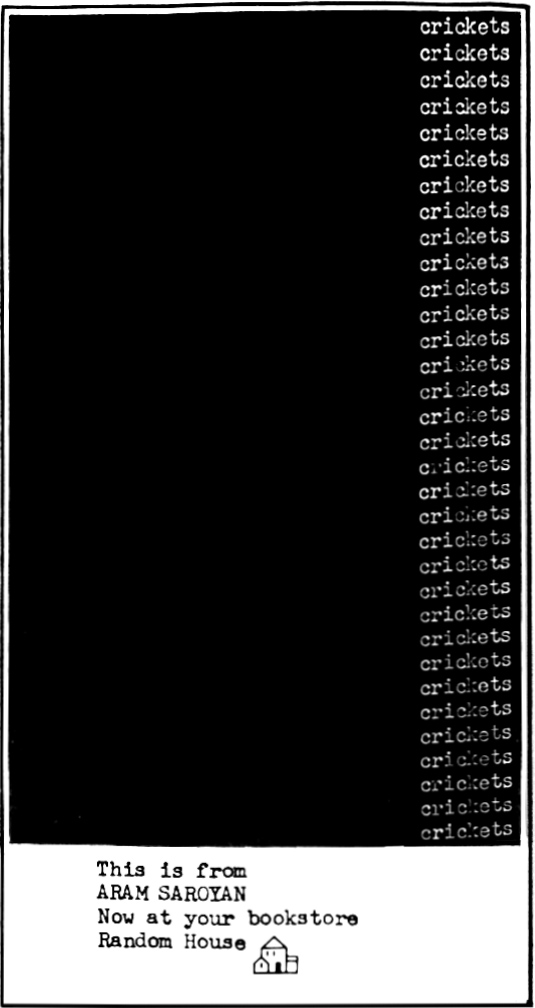
According to the author, the poem “was written in the spring of 1965 in an apartment building on East 45th in New York City, proving that crickets are powerful creatures, capable of penetrating New York City itself.” Interestingly, Saroyan repeats the word “crickets” about 33 times per minute — not far off from the 30 chirps per minute produced by the North American field cricket. (The speed at which a cricket chirps is determined by species and temperature — it is even possible, following Dolbear’s Law, to determine the temperature outdoors by counting the frequency of cricket chirps.)
The poem may well have been influenced by a poem from Zukofsky’s “All,” first published in 1965. Zukofsky’s poem — a mere 19 words in 16 lines — begins with “Crickets’ / thickets” and ends with “are crickets’ / air.” Saroyan in fact recalls visiting Zukofsky with Clark Coolidge in New York City not long after the column of crickets had been published in Lines six in November 1966, he tells me: “Louis mentioned the poem right away, saying something like ‘Alright, but what about’ and here he switched into mellifluous recitation — ‘crickets’ / thickets // light, delight.’ He didn’t go on long but it was clear I had gone too far for his tastes.”
Saroyan’s isolation of the single word had powerful effects: It denarrativized and decontextualized language, and it placed the word in stark relief.
Saroyan’s other two contemporaneous cricket poems play on the sonic and visual properties of the word in other ways. Also a single column, “crickets / crickess / cricksss . . .” removes one letter from the word for eight lines and then re-adds a letter for each line. The word “cricket” disappears and reappears visually among the additional s’s. Saroyan’s “not a cricket,” by contrast, plays with a sonic and semantic paralipsis:
not a
cricket
ticks a
clock
Although it was not written specifically for The Dial-a-Poem Poets, that recording is crucial to understanding the poem. Saroyan reads the poem slowly as if it were a radio or telephone announcement of the time, and “ticks a / clock” sounds very much like “six o’clock” (perhaps in reference to the iconic chimes of Big Ben that have been broadcast worldwide daily by the BBC at six o’clock since 1924). Although “ticks a” half-rhymes with “cricket,” it is not the same word, as in the other “crickets” poems. Moreover, the poem plays a trick similar to Magritte’s “Ceci n’est pas une pipe” or George Lakoff’s “Don’t Think of an Elephant”— it negatively conjures something, as if to suggest a cricket doesn’t make a sound like a clock. Or perhaps there is a silence so deep that only a clock can be heard.
“crickets” and “not a cricket” can be usefully compared to another contemporaneous poem by Saroyan: simply the word “tick” centered on two facing pages. Like the crickets poems, it is onomatopoeic, and in fact may sound more like a clock than the conventional English “tick-tock” or the French “tic-tac” (the Italian candy, introduced in 1969, is said to have taken its name from the sound of the candies rattling in their container). A clock does not have two sounds that alternate every other second; it has one.
“Tick” in this context will bring a clock to mind for most readers, but here again the lack of context could be suggestive. Tick as a noun might suggest two insects. Or it might suggest another meaning of “tick” as a verb, such as to tick something off a list. Saroyan’s use of the facing pages is ingenious, however, and indicates the tick as a unit of time, although the poem (as Saroyan suggested was his intent with the minimal poems) may not involve any durational reading process, as one might see both ticks stereoscopically at once. The poem originally appeared in the experimental literary magazine 0 To 9 and would not have been possible to include in Saroyan’s three main books of minimal poetry, as these all had poems printed on the right-hand pages only. Saroyan’s isolation of the single word had powerful effects: It denarrativized and decontextualized language, and it placed the word, typically a noun, in stark relief. In a letter which accompanied the poem, Saroyan wrote to artist Vito Acconci in September 1967 that
I’ve discovered that the best work I can do now is to collect single words that happen to strike me and to type each one out in the center of a page. The one word isn’t “mine” but the one word in the center of the page is. Electric poems I call them (in case anyone starts throwing Concrete at me)—meaning that isolated of the reading process—or that process rendered by the isolation instant—each single word is structure as “instant, simultaneous, and multiple” as electricity and/or the Present. In effect the single word is a new reading process; like electricity—instant and continuous.
Saroyan’s version of minimal writing energized Vito Acconci to turn in the opposite direction, toward a maximal style that likewise can present extreme difficulties of interpretation. Acconci’s late-60s writing included in 0 To 9 especially emphasizes the contrasting styles. “tick . . . tick” is in fact embedded within a long and elaborate Acconci poem called “ON” that took up much of issue three of 0 To 9. Acconci describes his all-or-nothing reaction to Saroyan’s poems:
In the late Sixties, when I called myself a poet, Aram was the poet I envied. Because you couldn’t be sure if he was fooling or if he had really gotten to all there is to get. Because while the rest of us tried to be verbs, like everybody told us to do, he had the nerve to stop at nouns. Because he took a deep breath and willed himself into the self-confidence of naming. Because it wasn’t “nouns,” it was “noun,” only one noun, because he boiled it all down to one. Because then he let himself go, he let himself stutter, he let the one go and let the one double and go out of focus: while the rest of us ran for our lives all over the place and over the page, his noun shimmered and breathed and trembled and moved—shh! softly, softly—from within.
As Acconci well knew, many of the one-word poems were the result of felicitous typos or language appropriated from the ambient surroundings; and in fact, in many cases Saroyan’s method of appropriating text and sound was similar to Acconci’s, although Saroyan worked in smaller units. But Acconci also ascribed to Saroyan’s writing a powerful interiority because he attempted to avoid such interiority in his own dense, informatic writing of the late 1960s and early 70s.
Many of Saroyan’s poems have a more interesting media history than is generally recognized. Saroyan’s most famous one-word poem, “lighght,” for instance, became famous (or infamous) several years after it was in written in the fall of 1965, and was first published as a 24″ × 36″ poster by Brice Marden in early 1966. As part of a set of five Electric Poems posters, lighght (the title is italicized when it is considered as an artwork) was printed in yellow, as if to suggest sunlight. Around the same time, it was printed in red in Saroyan’s self-published “Works,” which contained 24 minimal poems.
It was not until 1970 that the poem was to gain widespread notoriety, when Congressman William Scherle decried the poem on the floor of Congress, noting that the National Endowment for the Arts had spent $107 per letter on the poem. In retrospect, the controversy over “lighght” was an opening salvo in the battle over NEA funding that continues to this day. As in the reaction to so many works of avant-garde and minimal art, the resistance to this work lay in the supposed lack of skill or effort to create it.
Although he had not yet read Marshall McLuhan when he wrote the poem, Saroyan drew on McLuhan in offering a reading of the poem: “Why only a single word—and a misspelled word at that? Let me stick with McLuhan, who wrote that the electric-television era of communication has three fundamental characteristics: (1) It is instant. 2) It is simultaneous. 3) It is multiple,” he wrote in an account of the controversy for Mother Jones. “A one-word poem is, in its own way, a structure that embodies all of McLuhan’s essential characteristics and hence reflects the unique reality of the time during which it was made.”
“A one-word poem is, in its own way, a structure that embodies all of McLuhan’s essential characteristics and hence reflects the unique reality of the time during which it was made.”
Saroyan seems to allude to the opening pages of “Understanding Media” in which McLuhan claims, “The electric light is pure information,” and that “the ‘message’ of any medium or technology is the change of scale or pace or pattern that it introduces in human affairs.” McLuhan’s media-deterministic account of television and global telecommunication is in many respects a good fit for a defense of minimalism, particularly given that McLuhan emphasizes scale and speed as important components of communication and expression.
But “lighght” may not be as void of content as it first appears. The poem may look like a felicitous typo (like “eyeye”), but the poem was not the result of an accident. One possible inspiration for the poem might even have been Zukofsky’s “crickets’ / thickets // light / delight.” In the version of that poem published in 1965, the words “light” and “delight” align vertically so that if one were to delete the “deli,” the result could be “lighght.” Saroyan himself has suggested some possible implications of his poem, claiming, as he does in his collection of essays and reviews, “Door to the River,” that the effect of the poem is “to render light itself more palpable, as if the word holds the phenomenon.” A number of commentators have noted that the poem evokes vibrating light waves. “Light” can be a noun, verb, or adjective in English. The extra “gh” is unpronounceable and intangible. Or perhaps one might elongate the word and stretch out the i sound. In practice, I’ve generally heard the poem read aloud as a list of letters, L-I-G-H-G-H-T, rather than as a single syllable — thus turning the poem into seven syllables.
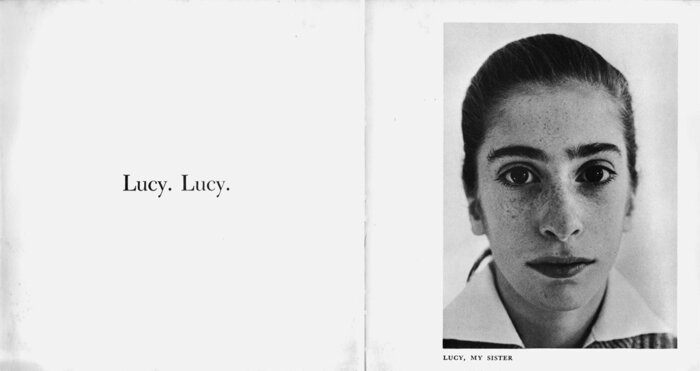
Saroyan conceived his one-word poems as being fundamentally photographic, as his 1970 “Words & Photographs” made more clear than the earlier minimal books. Having worked as photographer Richard Avedon’s assistant as a high school student, Saroyan in this book juxtaposed verso poems with recto photographs. Like much of Saroyan’s later work, “Words & Photographs” is largely autobiographical and begins with photographs of his family. The first image/poem in the book is of his sister, whose name, Lucy, is cognate with “light.” The back-cover text seemingly alludes to this when it claims: “The combination of photo and poem is at times haunting and cryptic, at times witty, and always lucid.” Unlike his more austere earlier one-word poems, the poems in “Words & Photographs”are each punctuated with periods, as if to create a one-to-one mimetic correspondence of word and image. In common with many one-word poems, the text is effectively metonymic — metaphor and narrative are precluded. The centered text on the left page symmetrically mirrors the image on the right, and the repetition gives the sense of an infinite echo.
“lighght” may look like a felicitous typo but the poem was not the result of an accident.
Not all of Saroyan’s minimal poems were so austerely black and white as they are in his early books or in “Complete Minimal Poems.” Produced in the summer of 1965, “TOP”(spoiler alert) consists of the title and a single word that can be difficult to distinguish at first (and thus “TOP”seems to qualify as a one-word poem, according to Finlay’s definition). The one word, which never appears all at once on any single panel, is simply “GOING.”
“TOP” is almost a work of op art in its deployment of the diamond shape of a spinning top. Its use of the stencil form gives the panels an almost militaristic sensibility, and a number of the panels contain only O’s and I’s, which in the stencil format can easily be seen as zeros and ones, suggesting binary code. The spatial deployment of letters and colors in “TOP” is ingenious: The center panel of the front (or top) side consists only of red O’s (or zeros), as if to suggest that the top has reached maximum speed and has become blurred in our vision. I included a spoiler alert above because I think “TOP” should be read with fresh eyes in order to be appreciated, as there is generally a delay between a reader’s apprehension of the letterforms on the page and recognition of the specific word. The poem can’t help but invoke the cliché of “going, going, gone,” and even if it only takes 30 seconds to cognize “going,” that delay will almost surely be a component of a reading process that all too soon will be gone.
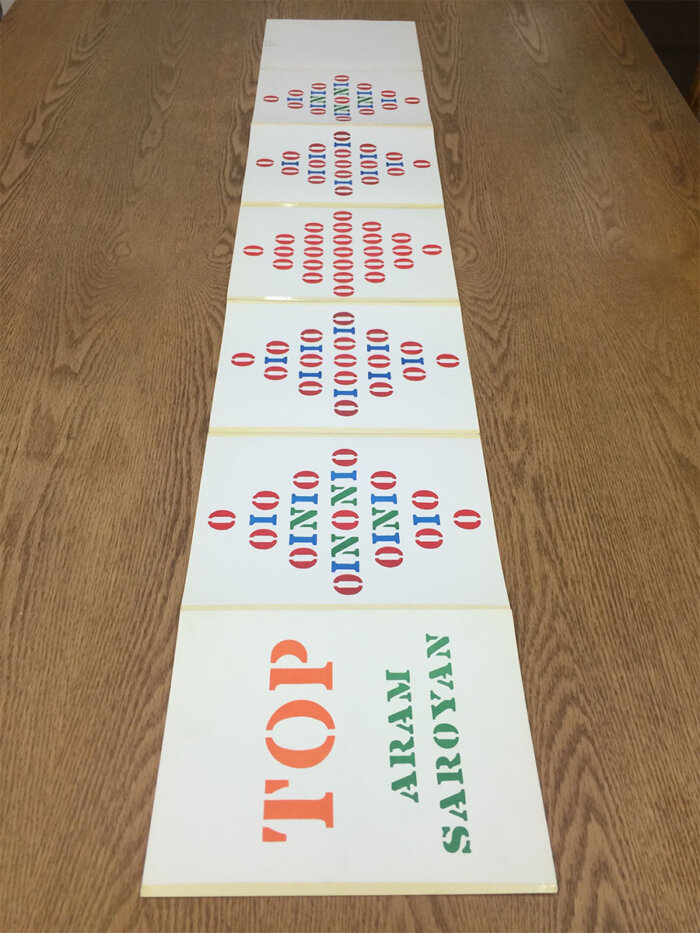
Toward the end of Saroyan’s minimal phase, in late 1967 and early 1968, his writing became sparser and more conceptual. “©1968”— or “Ream” — is merely a blank 500-page ream of paper. It might also be read as a one-word poem whose one word is implied but never directly stated. As a farewell to minimal poetry, the gesture could hardly be more perfect. “©1968,” about which Craig Dworkin writes extensively in “No Medium,” a book comprising readings of ostensibly “blank” works, adopts the standard medium of the typewriter, while seemingly rejecting content altogether. The scale of the ream is infinitely out of proportion to its contents — and yet “©1968”can be understood as a sculptural object as well as a work of conceptual literature. The title makes the object Saroyan’s intellectual property, and yet there is nothing to protect. The author’s assertion of rights mocks an entire system of authorship at the same time that it reinscribes it by including only the author’s name and copyright. The blank pages could be the potential work of everyone and no one — except for the simple assertion of Saroyan’s role.
Saroyan’s minimal poems offer a loving parody of both fame and the graphomania that often accompanies literary fame. At the same time that Saroyan was assembling his three main collections of minimal poems, a remarkable cultural development was taking place, as documented by Roger Gastman in “Wall Writers”:
while you can’t tell exactly when graffiti started, we’re able to put a fairly accurate date on when it changed in a way that would transform city life, public transit, public art, and ultimately visual art the world over. In Philadelphia and New York City, roughly contemporaneous with the 1967 Summer of Love, was when graffiti began to change: The idea became to write your name or moniker all over the city, in a stylish way, again and again and again, with a goal of street fame and self-expression. That same basic idea basically defines modern graffiti.
There is no direct relation between Saroyan’s practices and those of graffiti writers, nor is there any indication that Saroyan was aware of graffiti at the time. But a loose comparison can be suggestive: Both Saroyan and the graffiti writers were engaged in more or less noncommercial art practices. The book “Aram Saroyan,” not unlike a graffiti tag, established his name within a subculture — in part by refusing The Great American Novel type of book that might be expected of the son of a famous writer whose fame had faded, but whose life remained defined by an extreme dedication to his writing.
Saroyan’s minimal poems offer a loving parody of both fame and the graphomania that often accompanies literary fame.
The younger Saroyan had seen up close the effects of fame all his life, and in the spring of 1967, the interview of Jack Kerouac that he conducted, with Ted Berrigan and Duncan McNaughton, offered a particularly strong cautionary tale. Not long after, Saroyan auditioned for the lead role in Mike Nichols’s “The Graduate,” but walked away in order to pursue his writing. The minimal poems were, in their way, the ultimate renunciation of the role of author as oracle and performer. For Dworkin, Saroyan’s early books can be read “as scenes in a sorry family drama,” and yet “each of these early books asserts Aram Saroyan’s own right to be identified with the typewriter, however long the shadow cast by his celebrity father’s own identification with the machine.” “[F]or all their whimsical irony,” Dworkin concludes, “the critiques [these books] wager are bought at the cost of insisting on literary value, not negating it.”
A little-known 1971 poem (not collected in “The Complete Minimal Poems”) gives a good sense for how the one-word poem can be both banal and profound. The poem is simply the eight letters of the word “activity” repeated eight times (possibly vaguely evoking the Beatles’ song “Eight Days a Week”). Like the obsessive repetitive emptiness of Vito Acconci’s “Read This Word” or Hanne Darboven’s “Words,” the poem goes nowhere and everywhere.
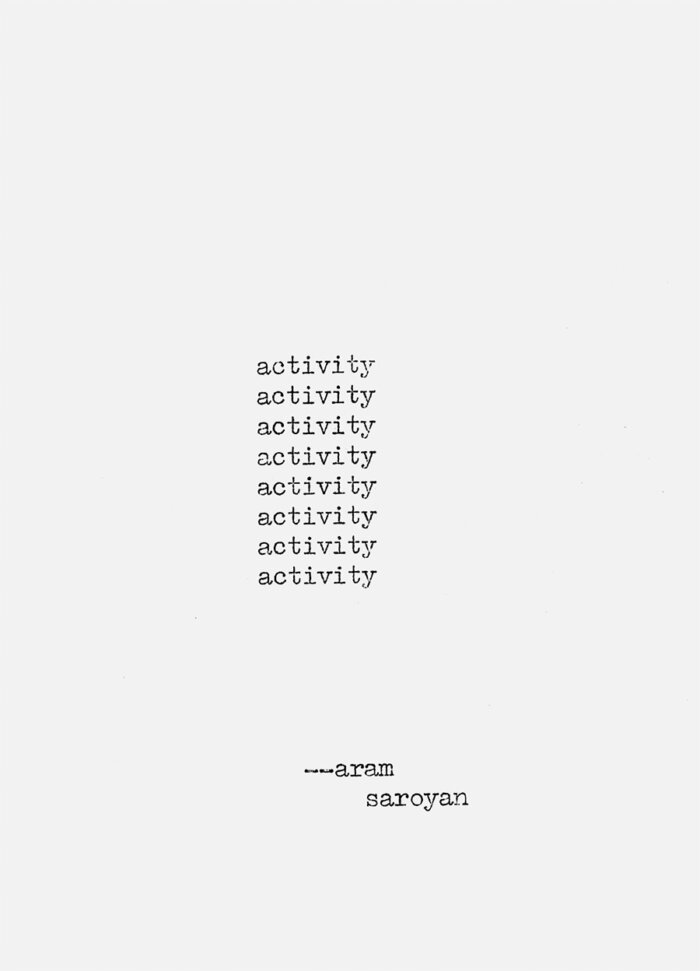
Life itself can be described as an activity — or it could be described as the sum of our activities. “Activity” is a measure of vitality, but “activities” in the plural can suggest a routinization or lack of differentiation, as in a sentence like “I can hardly keep up with all of my child’s activities.” The repeated “activity” invites metonymic substitution: The poem could be rewritten as “writing / sleeping / smoking / seeing,” etc. — although for me the poem would seem to ask to be readself-reflexively as a commentary on the activity of writing.
As someone who writes and who studies writers, I often wonder why writers write so much. In many cases, the activity itself must give satisfaction, since conventional utilitarian considerations cannot possibly pertain. In other cases, the activity must seem like an onerous burden. The one-word poem inverts the graphomanic impulse — but it also plunges us into an abyss of linguistic vagueness, jolting us from a passivity in which we suppress the mysteriousness of language: where letters disappear into words and words disappear into sentences and sentences disappear into books and books consume their authors. Here, for the active reader, that process might be reversible.
Paul Stephens is the editor of the journal Convolution, and the author of “The Poetics of Information Overload: From Gertrude Stein to Conceptual Writing” and “absence of clutter: minimal writing as art and literature,” from which this article is adapted.



